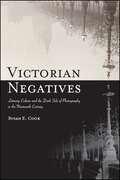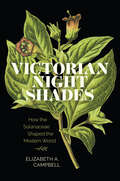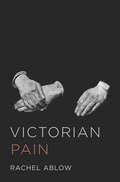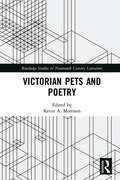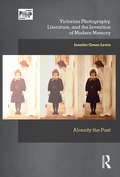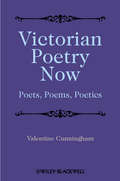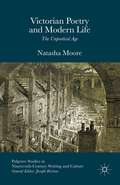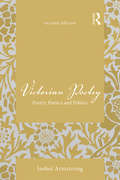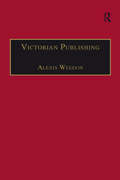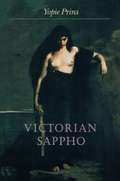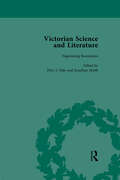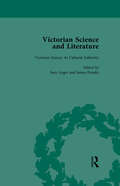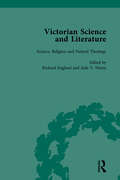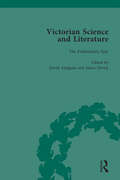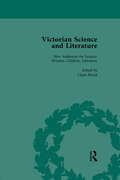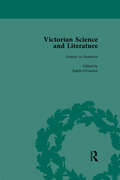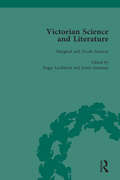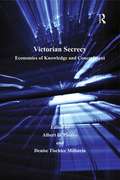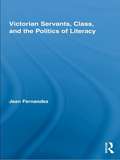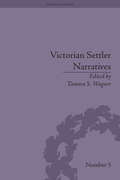- Table View
- List View
Victorian Negatives: Literary Culture and the Dark Side of Photography in the Nineteenth Century (SUNY series, Studies in the Long Nineteenth Century)
by Susan E. CookVictorian Negatives examines the intersection between Victorian photography and literary culture, and argues that the development of the photographic negative played an instrumental role in their confluence. The negative is a technology that facilitates photographic reproduction by way of image inversion, and Susan E. Cook argues that this particular photographic technology influenced the British realist novel and literary celebrity culture, as authors grappled with the technology of inversion and reproduction in their lives and works. The book analyzes literary works by Charles Dickens, Arthur Conan Doyle, E. W. Hornung, Cyril Bennett, Robert Louis Stevenson, Oscar Wilde, Thomas Hardy, and Bram Stoker, and puts readings of those works into conversations with distinct photographic forms, including the daguerreotype, solarization, forensic photography, common cabinet cards, double exposures, and postmortem portraiture. In addition to literary texts, the book analyzes photographic discourses from letters and public writings of photographers and the nineteenth-century press, as well as discussions and debates surrounding Victorian celebrity authorship. The book's focus on the negative both illuminates an oft-marginalized part of the history of photography and demonstrates the way in which this history is central to Victorian literary culture.
Victorian Nightshades: How the Solanaceae Shaped the Modern World (Victorian Literature and Culture Series)
by Elizabeth A. CampbellA darkly alluring plant family and the arrival of modernityVictorian Nightshades tells the story of how one plant family—notorious for centuries in England because of its frequently psychoactive and poisonous properties—rose to social and economic prevalence during the nineteenth century. Beginning with bittersweet and belladonna, the Old World species associated with evil, witchcraft, and dangerous women in an era when traditional botanical beliefs not only assigned morality to plants but also gendered them, Campbell then moves to the ubiquitous potato and tobacco before concluding with four of the Solanaceae that achieved the widest national favor by the end of the century: the ornamental petunia and the edible pepper, eggplant, and tomato. The story of the nightshades exposes the conflicts between science and popular sentiment and between knowledge and received opinion that defined the nineteenth century. Campbell compellingly details how advances in medical and botanical knowledge, evolutionary theory, and the vagaries of human desire transformed the Solanaceae from a plant family plagued by fear and hostility in the British imagination to one of cultural favor and celebration by the turn of the century—encapsulating the Victorian era&’s course to modernity.
Victorian Noon: English Literature in 1850
by Carl DawsonOriginally published in 1979. Carl Dawson looks at the year 1850, which was an extraordinary year in English literary history, to study both the great and forgotten writers, to survey journals and novels, poems and magazines, and to ask questions about dominant influences and ideas. His primary aim is descriptive: How was Wordsworth's Prelude received by his contemporaries on its publication in 1850? How did reviewers respond to new tendencies in poetry and fiction/ Who were the prominent literary models? But Dawson's descriptions also lead to broader, theoretical questions about such issues as the status of the imagination in an age obsessed by mechanical invention, about the public role of the writer, the appeal to nature, and the use of myth and memory. To express the Victorians' estimation of poetry, for example, Dawson presents the contrasting views help by two eminent Victorians, Macaulay and Carlyle. In Macaulay's opinion, the advance of civilization led to the decline of poetry; Carlyle, on the other hand, saw the poet as a spiritual liberator in a world of materialists. The fusion of the poet's personal and public roles is witnessed in a discussion of the two mid-Victorian Poet Laureates, Wordsworth and his successor, Tennyson. In analyzing the relationship between the two writers' works, Dawson also highlights the extent of the Victorians' admiration for Dante. To give a wider perspective of the status of literature during this time, Dawson examines reviews, prefaces, and other remarks. Critics, he shows, made a clear distinction between poetry and fiction. Thus, in 1850, a comparison between, say, Wordsworth and Dickens would not have been made. Dawson, however, does compare the two, by focusing on their uses of autobiography. Dickens surfaces again, in a discussion of Victorian periodical publishing. Here, Dawson compares the Pre-Raphaelites' short-lived journal The Germ with Dickens' enormously popular Household Words and a radical paper, The Red Republican, which printed the first English version of "The Communist Manifesto" in 1850. In bringing together materials that have often been seen as disparate and unrelated and by suggesting new literary and ideological relationships, Carl Dawson has written a book to inform almost any reader, whether scholar of Victorian literature or lover of Dicken's novels.
Victorian Pain
by Rachel AblowThe nineteenth century introduced developments in science and medicine that made the eradication of pain conceivable for the first time. This new understanding of pain brought with it a complex set of moral and philosophical dilemmas. If pain serves no obvious purpose, how do we reconcile its existence with a well-ordered universe? Examining how writers of the day engaged with such questions, Victorian Pain offers a compelling new literary and philosophical history of modern pain.Rachel Ablow provides close readings of novelists Charlotte Brontë and Thomas Hardy and political and natural philosophers John Stuart Mill, Harriet Martineau, and Charles Darwin, as well as a variety of medical, scientific, and popular writers of the Victorian age. She explores how discussions of pain served as investigations into the status of persons and the nature and parameters of social life. No longer conceivable as divine trial or punishment, pain in the nineteenth century came to seem instead like a historical accident suggesting little or nothing about the individual who suffers.A landmark study of Victorian literature and the history of pain, Victorian Pain shows how these writers came to see pain as a social as well as a personal problem. Rather than simply self-evident to the sufferer and unknowable to anyone else, pain was also understood to be produced between persons—and even, perhaps, by the fictions they read.
Victorian People and Ideas
by Richard Daniel AltickThis book is rather like one of those "Music Minus One" records of a concerto, in which the orchestral accompaniment is present but the solo instrument lacking. The different voices of Victorian social and intellectual history here provide the background, that is to say, the thematic material which in a fully realized concerto is developed by the solo instrument. The unheard soloist-- the real center of interest-- is, of course, Victorian literature itself. The analogy is not quite perfect: literary history does figure more or less prominently in the opening chapter. But thereafter literature is present only in the form of frequent passing allusions, suggestions from the orchestra which, we are to understand, are taken up and elaborated by the soloist. The chapters that follow are designed, then, to supply the accompaniment by which Victorian literature can be made more intelligible and pertinent to a reader in the last quarter of the twentieth century. The accurate understanding of any era's literature depends to a greater or less extent on a grasp of its historical context, but the danger of misreading and of anachronistic criticism increases when one deals with literature so intimately connected with contemporary life as was that of the Victorians.
Victorian Pets and Poetry (Routledge Studies in Nineteenth Century Literature)
by Kevin A. MorrisonSome of the most celebrated poets of the Victorian era wrote—at times movingly or humorously—about their pets. They did so in a wider literary context, for poetry about pets was ubiquitous in the period. Animal welfare organizations utilized poems about canine and feline suffering in institutional publications to call attention to various abuses. Elegies and epitaphs over the loss of a beloved cat, songbird, or dog were printed on funeral cards, tombstones, and appeared in mass-produced poetry collections as well as those intended for an intimate circle of friends. Yet poems about pets, as well as attendant issues such as breeding and overpopulation, have not received the kind of critical analysis devoted to fictional works and short stories. With an introduction, afterword, and eight essays offering new perspectives on significant as well as lesser known poems, Victorian Pets and Poetry remedies this omission.
Victorian Photography, Literature, and the Invention of Modern Memory: Already the Past (Photography, History: History, Photography)
by Jennifer Green-LewisInvented during a period of anxiety about the ability of human memory to cope with the demands of expanding knowledge, photography not only changed the way the Victorians saw the world, but also provided them with a new sense of connection with the past and a developing language with which to describe it. Analysing a broad range of texts by inventors, cultural critics, photographers, and novelists, Victorian Photography, Literature, and the Invention of Modern Memory: Already the Past argues that Victorian photography ultimately defined the concept of memory for generations to come –including our own. In addition to being invaluable for scholars working within the emerging field of research at the intersection of photographic and literary studies, this book will also be of interest to students of Victorian and modernist literature, visual culture and intellectual history.
Victorian Poetry Now: Poets, Poems and Poetics (Wiley Blackwell Guides to Literature #25)
by Valentine CunninghamThis book is the definitive guide to Victorian poetry, which its author approaches in the light of modern critical concerns and contemporary contexts. Valentine Cunningham exhibits encyclopedic knowledge of the poetry produced in this period and offers dazzling close readings of a number of well-known poems Draws on the work of major Victorian poets and their works as well as many of the less well-known poets and poems Reads poems and poets in the light of both Victorian and modern critical concerns Places poetry in its personal, aesthetic, historical, and ideological context Organized in terms of the Victorian anxieties of self, body, and melancholy Argues that rhyming/repetition is the major formal feature of Victorian poetry Highlights the Victorian obsession with small subjects in small poems Shows how Victorian poetry attempts to engage with the modern subject and how its modernity segues into modernism and postmodernism
Victorian Poetry and Modern Life: The Unpoetical Age (Palgrave Studies in Nineteenth-Century Writing and Culture)
by Natasha MooreFaced with the chaos and banality of modern, everyday life, a number of Victorian poets sought innovative ways of writing about the unpoetic present in their verse. Their varied efforts are recognisably akin, not least in their development of mixed verse-forms that fused novel and epic to create something equal to the miscellaneousness of the age.
Victorian Poetry: Poetry, Poetics and Politics (Routledge Critical History Of Victorian Poetry Ser.)
by Isobel ArmstrongIn Victorian Poetry: Poetry, Poetics and Politics, Isobel Armstrong rescued Victorian poetry from its longstanding sepia image as ‘a moralised form of romantic verse' and unearthed its often subversive critique of nineteenth-century culture and politics. In this uniquely comprehensive and theoretically astute new edition, Armstrong provides an entirely new preface that notes the key advances in the criticism of Victorian poetry since her classic work was first published in 1993. A new chapter on the alternative fin de siècle sees Armstrong discuss Michael Field, Rudyard Kipling, Alice Meynell and a selection of Hardy lyrics. The extensive bibliography acts as a key resource for students and scholars alike.
Victorian Poets and the Changing Bible (Victorian Literature and Culture Series)
by Charles LaporteVictorian Poets and the Changing Bible charts the impact of post-Enlightenment biblical criticism on English literary culture. The eighteenth and nineteenth centuries saw a widespread reevaluation of biblical inspiration, in which the Bible's poetic nature came to be seen as an integral part of its religious significance. Understandably, then, many poets who followed this interpretative revolution--including Alfred, Lord Tennyson, Robert Browning, and Elizabeth Barrett Browning--came to reconceive their highest vocational ambitions: if the Bible is essentially poetry, then modern poetry might perform a cultural role akin to that of scripture. This context equally illuminates the aims and achievements of famous Victorian unbelievers such as Arthur Hugh Clough and George Eliot, who also responded enthusiastically to the poetic ideal of an inspired text.Building upon a recent and ongoing reevaluation of religion as a vital aspect of Victorian culture, Charles LaPorte shows the enduring relevance of religion in a period usually associated with its decline. In doing so, he helps to delineate the midcentury shape of a literary dynamic that is generally better understood in Romantic poetry of the earlier part of the century. The poets he examines all wrestled with modern findings about the Bible's fortuitous historical composition, yet they owed much of their extraordinary literary success to their ability to capitalize upon the progress of avant-garde biblical interpretation.This book's revisionary and provocative thesis speaks not only to the course of English poetics but also to the logic of nineteenth-century literary hierarchies and to the continuing evolution of religion in the modern era. Victorian Literature and Culture Series
Victorian Poets: A Critical Reader (Blackwell Critical Reader #9)
by Valentine CunninghamVictorian Poets: A Critical Reader features a collection of critical essays focusing on various aspects of Victorian-era poetry from the 1830s to the 1890s. Presents key criticism on Victorian poetry Features contributions from a variety of scholars in the field Illustrates the full range of critical approaches to the Victorian poets, including attention to texts, words, forms, modes, and sub-genres Offers fresh reinterpretations, many driven by contemporary ideological interests, including gender questions, selfhood, and body issues
Victorian Publishing: The Economics of Book Production for a Mass Market 1836-1916 (The Nineteenth Century Series)
by Alexis WeedonDrawing on research into the book-production records of twelve publishers-including George Bell & Son, Richard Bentley, William Blackwood, Chatto & Windus, Oliver & Boyd, Macmillan, and the book printers William Clowes and T&A Constable - taken at ten-year intervals from 1836 to 1916, this book interprets broad trends in the growth and diversity of book publishing in Victorian Britain. Chapters explore the significance of the export trade to the colonies and the rising importance of towns outside London as centres of publishing; the influence of technological change in increasing the variety and quantity of books; and how the business practice of literary publishing developed to expand the market for British and American authors. The book takes examples from the purchase and sale of popular fiction by Ouida, Mrs. Wood, Mrs. Ewing, and canonical authors such as George Eliot, Wilkie Collins, and Mark Twain. Consideration of the unique demands of the educational market complements the focus on fiction, as readers, arithmetic books, music, geography, science textbooks, and Greek and Latin classics became a staple for an increasing number of publishing houses wishing to spread the risk of novel publication.
Victorian Sappho
by Yopie PrinsWhat is Sappho, except a name? Although the Greek archaic lyrics attributed to Sappho of Lesbos survive only in fragments, she has been invoked for many centuries as the original woman poet, singing at the origins of a Western lyric tradition. Victorian Sappho traces the emergence of this idealized feminine figure through reconstructions of the Sapphic fragments in late-nineteenth-century England. Yopie Prins argues that the Victorian period is a critical turning point in the history of Sappho's reception; what we now call "Sappho" is in many ways an artifact of Victorian poetics. Prins reads the Sapphic fragments in Greek alongside various English translations and imitations, considering a wide range of Victorian poets--male and female, famous and forgotten--who signed their poetry in the name of Sappho. By "declining" the name in each chapter, the book presents a theoretical argument about the Sapphic signature, as well as a historical account of its implications in Victorian England. Prins explores the relations between classical philology and Victorian poetics, the tropes of lesbian writing, the aesthetics of meter, and nineteenth-century personifications of the "Poetess." as current scholarship on Sappho and her afterlife. Offering a history and theory of lyric as a gendered literary form, the book is an exciting and original contribution to Victorian studies, classical studies, comparative literature, and women's studies.
Victorian Science and Literature, Part I Vol 1
by Jonathan Smith Bernard Lightman Gowan Dawson James Paradis Suzy Anger David Amigoni Richard England James Elwick Piers J Hale Jude V NixonThis eight-volume, reset edition in two parts collects rare primary sources on Victorian science, literature and culture. The sources cover both scientific writing that has an aesthetic component – what might be called 'the literature of science' – and more overtly literary texts that deal with scientific matters.
Victorian Science and Literature, Part I Vol 2
by Jonathan Smith Bernard Lightman Gowan Dawson James Paradis Suzy Anger David Amigoni Richard England James Elwick Piers J Hale Jude V NixonThis eight-volume, reset edition in two parts collects rare primary sources on Victorian science, literature and culture. The sources cover both scientific writing that has an aesthetic component – what might be called 'the literature of science' – and more overtly literary texts that deal with scientific matters.
Victorian Science and Literature, Part I Vol 3
by Jonathan Smith Bernard Lightman Gowan Dawson James Paradis Suzy Anger David Amigoni Richard England James Elwick Piers J Hale Jude V NixonThis eight-volume, reset edition in two parts collects rare primary sources on Victorian science, literature and culture. The sources cover both scientific writing that has an aesthetic component – what might be called 'the literature of science' – and more overtly literary texts that deal with scientific matters.
Victorian Science and Literature, Part I Vol 4
by Jonathan Smith Bernard Lightman Gowan Dawson James Paradis Suzy Anger David Amigoni Richard England James Elwick Piers J Hale Jude V NixonThis eight-volume, reset edition in two parts collects rare primary sources on Victorian science, literature and culture. The sources cover both scientific writing that has an aesthetic component – what might be called 'the literature of science' – and more overtly literary texts that deal with scientific matters.
Victorian Science and Literature, Part II vol 5
by Bernard Lightman Marwa Elshakry Sujit Sivasundaram Gowan Dawson Claire Brock Roger Luckhurst Ralph O'Connor Justin SausmanThis eight-volume, reset edition in two parts collects rare primary sources on Victorian science, literature and culture. The sources cover both scientific writing that has an aesthetic component – what might be called 'the literature of science' – and more overtly literary texts that deal with scientific matters.
Victorian Science and Literature, Part II vol 6
by Bernard Lightman Marwa Elshakry Sujit Sivasundaram Gowan Dawson Claire Brock Roger Luckhurst Ralph O'Connor Justin SausmanThis eight-volume, reset edition in two parts collects rare primary sources on Victorian science, literature and culture. The sources cover both scientific writing that has an aesthetic component – what might be called 'the literature of science' – and more overtly literary texts that deal with scientific matters.
Victorian Science and Literature, Part II vol 7
by Bernard Lightman Marwa Elshakry Sujit Sivasundaram Gowan Dawson Claire Brock Roger Luckhurst Ralph O'Connor Justin SausmanThis eight-volume, reset edition in two parts collects rare primary sources on Victorian science, literature and culture. The sources cover both scientific writing that has an aesthetic component – what might be called 'the literature of science' – and more overtly literary texts that deal with scientific matters.
Victorian Science and Literature, Part II vol 8
by Bernard Lightman Marwa Elshakry Sujit Sivasundaram Gowan Dawson Claire Brock Roger Luckhurst Ralph O'Connor Justin SausmanThis eight-volume, reset edition in two parts collects rare primary sources on Victorian science, literature and culture. The sources cover both scientific writing that has an aesthetic component – what might be called 'the literature of science' – and more overtly literary texts that deal with scientific matters.
Victorian Secrecy: Economies of Knowledge and Concealment
by Denise Tischler MillsteinWhether commercial, personal, political, professional, or spiritual, knowledge was capital for the Victorians in their ongoing project of constructing a modern information-based society. Victorian Secrecy explores the myriad ways in which knowledge was both zealously accumulated and jealously guarded by individuals, institutions, and government entities in Victorian Britain. Offering a wide variety of critical approaches and disciplinary perspectives, the contributors examine secretive actors with respect to a broad range of subjects, including the narrator in Tess of the d'Urbervilles, John Henry Newman's autobiographical novel Loss and Gain, Richard Dadd's The Fairy Feller's Masterstroke, modes of detection in Bleak House, the secret history of Harriet Martineau's role in the repeal of the Corn Law, and Victorian stage magicians. Taken together, the essays provide a richly textured account of which modes of hiding and revealing articulate secrets in Victorian literature and culture; how social relations are formed and reformed in relationship to secrecy; and what was at stake individually, aesthetically, and culturally in the Victorians' clandestine activities.
Victorian Servants, Class, and the Politics of Literacy (Routledge Studies in Nineteenth Century Literature)
by Jean FernandezIn this volume, Fernandez brings the under-examined figure of the Victorian servant out of obscurity in order to tell the story of his or her encounter with literacy, as imagined and represented in nineteenth-century fiction, autobiography, pamphlets and diaries. A vast body of writing is uncovered on the management of servant literacy in Victorian periodicals, advice manuals, cartoons, sermons, books on household management, and pornography, thereby revealing that the domestic sphere was a crucial war zone in the battle over mass literacy. By attending to how fictional and nonfictional texts of the age feature literate servant narrators, she demonstrates how the issue of servant literacy as a cultural phenomenon has profound implications for our understanding of the nexus between class, mass literacy, voice and narrative power in the nineteenth century. The study reads canonical fiction by Mary Wollstonecraft, Emily Bronte, Elizabeth Gaskell, Wilkie Collins, and R.L. Stevenson alongside popular detective fiction by Catherine Crowe, the Diaries of Hannah Cullwick, and best-selling pamphlets of the age, while introducing to Victorian scholarship hitherto little known or unknown servant autobiographies that address life history as an engagement with literacy.
Victorian Settler Narratives: Emigrants, Cosmopolitans and Returnees in Nineteenth-Century Literature (Gender and Genre #5)
by Tamara S. WagnerThis edited collection from a distinguished group of contributors explores a range of topics including literature as imperialist propaganda, the representation of the colonies in British literature, the emergence of literary culture in the colonies and the creation of new gender roles such as ‘girl Crusoes’ in works of fiction.
